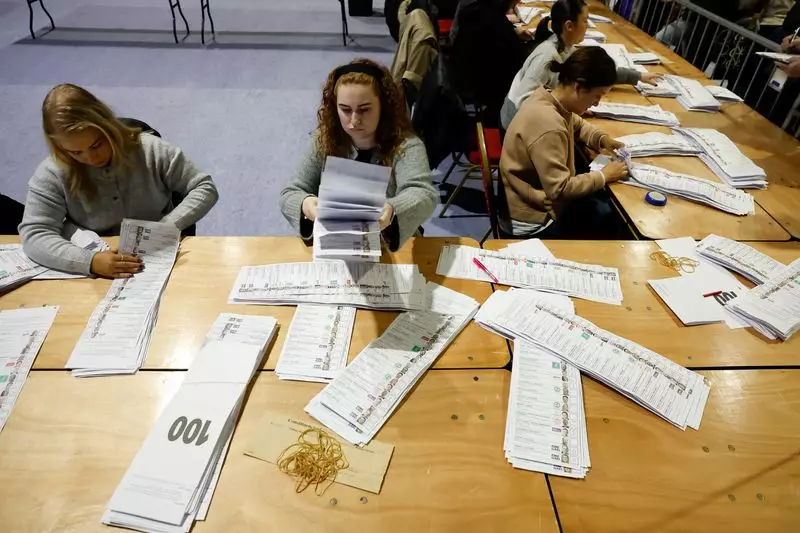In the wake of the recent Irish elections, the political arena is once again engulfed in uncertainty as the traditional centre-right parties, Fine Gael and Fianna Fáil, strive to reclaim their footing in government. The results of the election yield significant implications not only for Ireland’s domestic affairs but also for its economic stability, especially against the backdrop of international challenges such as the incoming U.S. administration’s proposed tax reforms and tariffs.
Analysis of the exit polls indicates that both Fine Gael and Fianna Fáil will likely return to power, with their support hovering around 21% and 19.5% respectively. Surprisingly, Sinn Féin has made a respectable showing, polling at 21.1%, overshadowing the traditional power dynamics in Irish politics. The reluctance of the two centre-right parties to form an alliance with Sinn Féin raises critical questions about the prospect of achieving a stable government.
Political analysts, including Dublin City University’s Professor Gary Murphy, posit that while Fine Gael and Fianna Fáil could collectively secure approximately 80 seats in the Dáil Éireann, this would fall short of the 88 needed for a majority. The search for junior coalition partners becomes a pivotal focus for the impending government. Given the dwindling fortunes of smaller centre-left parties like Labour and the Social Democrats, finding reliable allies to bolster their numbers will prove to be a daunting task.
Establishing a solid coalition is fraught with complications. With the incumbent coalition partner, the Greens, witnessing a significant drop in voter support—from 7% four years ago to just 4%—their representation may plummet from 12 seats to a mere 3. Such a significant drop further complicates the coalition-building process and suggests that a government consisting of several smaller parties might be inherently unstable.
Political stability will hinge not only on securing the necessary seats but also on harmonizing divergent interests within the coalition. A multi-party coalition, particularly with four partners, could predispose the government to internal strife and policy gridlock, reducing its effectiveness in addressing Ireland’s pressing issues.
As Prime Minister Simon Harris called for the election post a lavish €10.5 billion giveaway budget meant to incentivize voter support, questions loom over the sustainability of such economic measures. The budget, funded by an inflow of corporate tax revenues from multinational companies, serves as a double-edged sword. While it may temporarily elevate public sentiment, it simultaneously exposes the Irish economy to external risks, notably the policies of the incoming U.S. administration under President-elect Donald Trump. The proposed cuts to corporate tax could severely impact Ireland’s economically beneficial relationships with multinational firms.
Moreover, during the campaign, Fine Gael’s strategy was marred by public relations pitfalls—an incident involving Harris caught on camera walking away from a distressed care worker underscored a disconnect between the government and its constituents. This misstep serves as a stark reminder that perceptions of public service delivery are critical in shaping voter behavior.
On the opposition front, Sinn Féin’s evolving political narrative is noteworthy. Once projected to lead the government, the party’s fortunes have ebbed, primarily stemming from constituency discontent regarding its immigration policies. This reveals deeper complexities within the Irish political landscape: a working-class base wrestling with identity, economic, and social concerns may view the party’s policies as progressively misaligned with their interests.
Despite any setbacks, Sinn Féin’s robust polling reflects a palpable demand for change among the electorate, signaling a potential shift in the political paradigm. It raises the question of whether traditional parties like Fine Gael and Fianna Fáil can effectively navigate the changing tides of public sentiment while contending with the pressures of coalition governance.
As Ireland moves forward from the recent elections, the road to a new government is laden with uncertainties and challenges. The traditional power dynamics are being tested as voter preferences evolve and the pressures of global economics loom large. Whether Fine Gael and Fianna Fáil can forge a stable coalition, ensure effective governance, and respond to an increasingly dynamic electorate remains to be seen. In these challenging times, one narrative remains clear: the Irish political landscape is in flux, reflecting the complexities of modern governance in an interconnected world.

